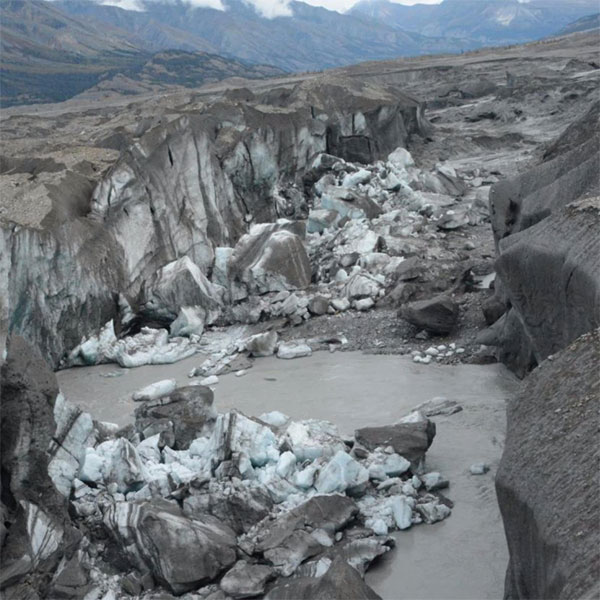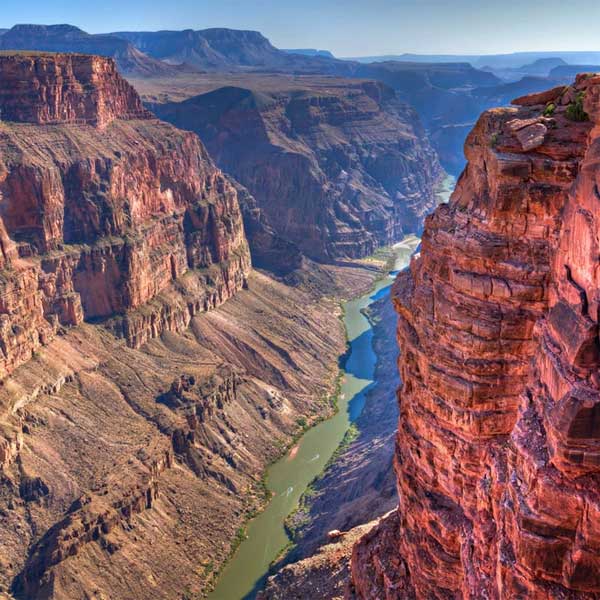In the 21st century, this is astonishing!
Is the Lifeblood of the Earth Being “Murdered”?
A new study led by researchers from McGill University (Canada) and the French National Research Institute for Agriculture, Food and Environment (INRAE) has found that approximately 51-60% of the total length of rivers and streams on Earth, which is 64 million km, cease to flow seasonally or run dry for at least one day each year.
One example of this phenomenon is the Slims River in Canada. For the first time in modern history, scientists witnessed a large river completely vanish in just… 96 hours! The Slims River is fed by meltwater from the Kaskawulsh Glacier, the largest glacier in Canada. The entire water flow of this river, which averages 480 meters in width, disappeared entirely.

The canyon with ice walls at the end of the Kaskawulsh Glacier, with newly collapsed ice blocks. (Credit: Jim Best/University Of Illinois)
Scientists refer to this unusual phenomenon as “River Piracy” to describe rivers that abruptly run dry. The phenomenon of “River Piracy” has been documented for thousands, even millions of years. In the 21st century, this is truly astonishing!
At the end of February 2021, the SCMP reported that the Yangtze River (also known as Chang Jiang) has been “murdered” by human activities to the point of gradual death. After decades of sand dredging, dam construction, rampant exploitation, pollution, and overfishing, the Yangtze River is slowly dying.
After decades of reviewing records from ground stations and satellite imagery, researchers estimate that the average water level of the Yangtze River has decreased by about 2 cm every 5 years since the 1980s. Once a clear stream, the longest river in Asia and the third longest in the world has turned murky and foul-smelling.
Whether objectively or subjectively, rivers large and small around the world are being negatively impacted.
Why is This Happening?
Mathis Messager, the lead author of the study and a PhD geography student at both McGill University (Canada) and INRAE, stated: “These rivers can provide vital water and food sources for people. They play a crucial role in controlling water quality. However, it is noteworthy that they are often mismanaged or completely excluded from management activities and conservation laws.”
Bernhard Lehner, an associate professor in the Geography Department at McGill University, added: “In the context of global climate change, relentless global warming, and increasing land use demands due to population growth, an increasing proportion of the global river network will cease to flow seasonally in the coming decades.”
In fact, many long-standing rivers and streams, including iconic stretches like the Nile (Egypt), Indus (Pakistan), and Colorado River (North America), have become non-flowing over the past 50 years due to climate change and land use conversion, either temporarily or permanently.
National Geographic has reported that the Yellow River (5,464 km long, the second-longest river in Asia), Murray River (2,375 km long, Australia), and Rio Grande (3,051 km long, North America) are among the rivers on the planet at risk of gradually disappearing due to climate change and the overuse of water and river resources by humans.
In reality, anthropogenic climate change not only causes rivers and streams to behave abnormally, but it also endangers human lives and livelihoods. Never has this issue been so urgent and widespread.
The sickness of rivers could affect drinking water sources, resources beneath the river (fish, shrimp…), and may very well lead humanity into a global clean water crisis.

The Colorado River flowing through the Grand Canyon. (Photo: Tonda/Getty Images/iStockphoto)
The researchers were able to identify the most important environmental characteristics in determining whether a river ceases to flow seasonally by combining statistical analyses of long-term water flow records from 5,615 locations worldwide with information on hydrology, climate, geology, and land cover around the monitored rivers and streams.
They found that, as expected, the most common non-flowing rivers are located in arid areas (where evaporation exceeds precipitation), and smaller rivers and streams tend to have more variable flows and are therefore more likely to run dry. However, they also appear in tropical climates and even in the Arctic, where rivers freeze for extended periods throughout the year.
The work of Mathis Messager’s team is the first empirically-based effort to quantify the global distribution of non-flowing rivers and streams. The research published in the journal Nature calls for a shift in river science and management by revising the fundamental concepts traditionally thought to represent ‘perennially flowing waters’ in rivers and streams.
The mapping also provides critical baseline information for assessing future changes in flow disruption of rivers and streams and for identifying or monitoring the roles of these rivers and streams in the global natural water system.


















































